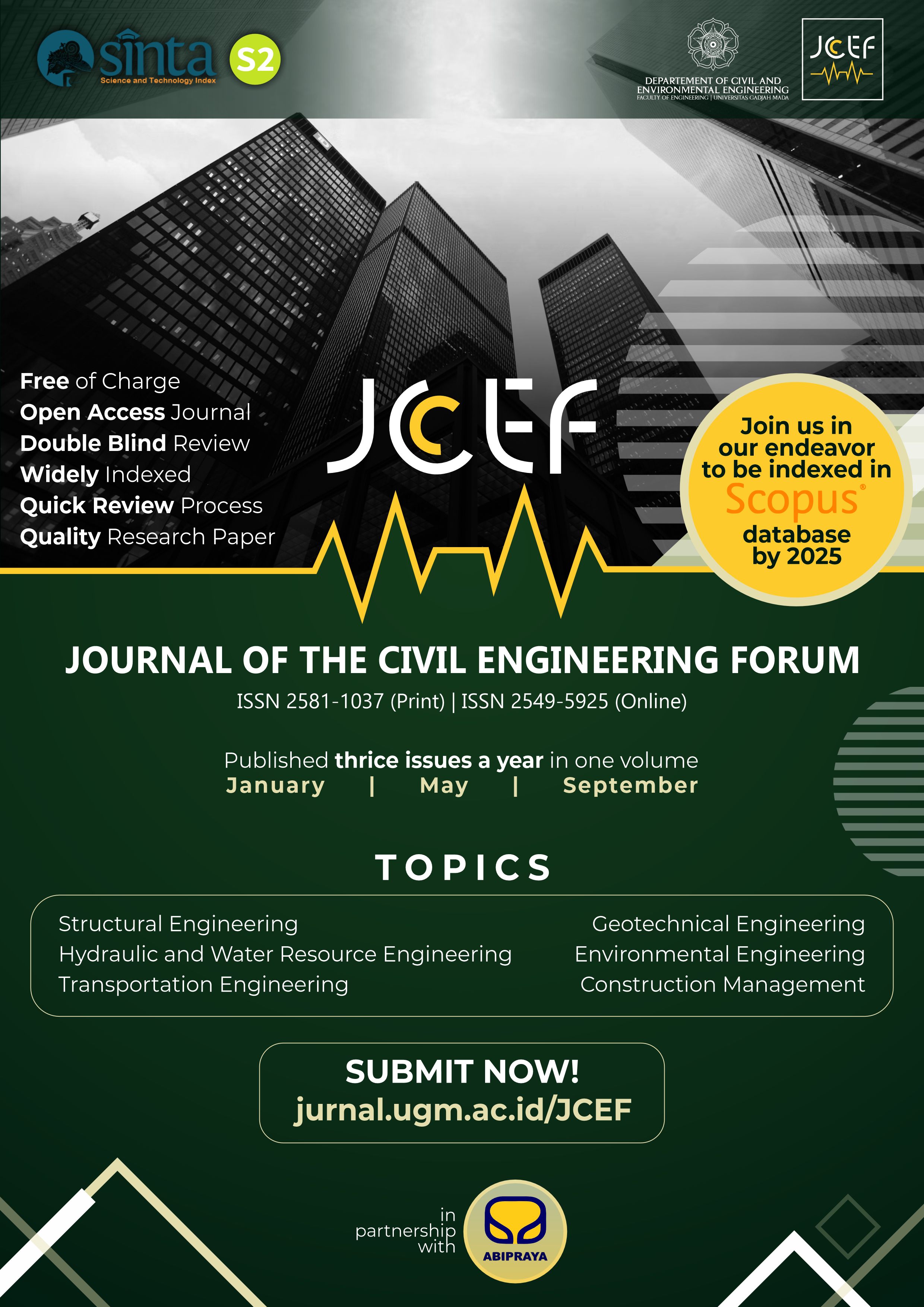Factors Affecting Cyclist Behaviours in the Special Region of Yogyakarta
Abstract
Bicycle-riding/cycling has reportedly become a new trend in various cities of Indonesia, as well as the Special Region of Yogyakarta, amidst the social restriction applied by the Government to decrease the spreading rate of the COVID-19 virus. This is observed to be a healthier effort in strengthening the immune system during the pandemic. However, the positive growth of this trend is proportional to the increasing data on bicycle accidents. This was due to the increased rate of injured and dead victims from 2017 to 2020. The human behavior factor is also one of the factors causing the high rate of these bicycle accidents. Therefore, this study aims to analyze the factors affecting the behavior of cyclists in the Special Region of Yogyakarta, to reduce the continuous increase of accidents. The data used in this study were the result of the Cyclist Behavior Questionnaire (CBQ) on the Yogyakarta riders. The samples were obtained through the purposive sampling method, using an online questionnaire with a google form and acquiring 362 respondents. Furthermore, the analytical method used was the structural equation modeling (SEM), through the AMOS 22.0 software. The results indicated that the regulation scale directly affected risk perception and cyclist behaviors (risky and positive). However, age only affected their behaviors, which did not directly affect the accidents. The regulation scale then directly affected the risky behavior of cyclists, with risk perception observed as the mediator, implying that the cyclists' knowledge of road safety regulations influenced individual behaviors. In conclusion, these results are expected to be one of the considerations in the policy of the government, to carry out the overall development of transportation, especially bicycles.
References
Arifin, M. Z., Wicaksono, A. & Permata, N. D., 2018. Kajian Strategi Penanganan Program Keselamatan Pesepeda. Malang, Prosiding Simposium Forum Studi Transportasi antar Perguruan Tinggi ke-21 Universitas Brawijaya.
Bike to Work, 2020. https://www.b2w-indonesia.or.id/. [online] Available at: https://docs.google.com/spreadsheets/d/e/2PACX-1vTaLpFotxAoQN_ljx3GXkoakMJpesxwSTk-3EfQnPD_mpDNzoMKeZn5671M7atI1cdbk7S1DHYqsbi8/pubhtml [Accessed 22 November 2020].
Deniati, E. N. & Annisaa, 2021. Hubungan Tren Bersepeda dimasa Pandemi Covid-19 dengan Imunitas Tubuh Lansia. Sport Science and Health, 3(3), pp. 125-132.
Ghozali, I., 2008. Model Persamaan Struktural, Konsep dan Aplikasi dengan Program AMOS 16.0. Semarang: Badan Penerbit Universitas Diponegoro.
Haryono, S., 2016. Metode SEM Untuk Penelitian Manajemen dengan AMOS, LISREL, PLS. Bekasi: PT. Intermedia Personalia Utama.
Heinen, E., van Wee, B. & Maat, K., 2010. Commuting by Bicycle: An Overview of The Literature. Transport Review, 30(1), pp. 59-96.
Ika, 2020. Universitas Gadjah Mada. [online] Available at: https://ugm.ac.id/id/berita/19632-pakar-ugm-jelaskan-cara-aman- bersepeda-di-tengah-pandemi-corona [Accessed 6 May 2021].
Kementerian Perhubungan RI, 2020. PM 59 Tahun 2020 Tentang Keselamatan Pesepeda di Jalan. Jakarta: s.n.
Kompas.com, 2020. Ramai Pesepeda di Perempatan Tugu Yogya, Bagaimana Penjelasnnya?. [Online] Available at : https://www.kompas.com/tren/read/2020/07/12/151000165/ramai-pesepeda-di-perempatan-tugu-yogyakarta-bagaimana-penjelasannya- [Accessed 26 November 2020].
Kummeneje, A.-M. & Rundmo, T., 2020. Attitudes, risk perception and risk-taking behaviour among regular cyclists in Norway. Transportation Research, 69, pp. 135-150.
Lawson, A. R., Pakrashi, V., Ghosh, B. & Szeto, W., 2013. Perception of Safety of Cyclists in Dublin City. Accident Analysis and Prevention, 50, pp. 499-511.
Mandic, S., Flaherty, C., Pocock, T., Kek, C. C., McArthur, S., Ergler, C., ChilLón, P., Bengoechea, E. G., 2018. Effect of Cycle Skill Training on Children's Cycling-Related Knowledge, Confidence and Behaviour. Journal of Transport & Health, 8, pp. 271-282.
Ministry of Health of RI, 2018. Directorate of Health Promotion and Community Empowerment. [online]. Available at: https://promkes.kemkes.go.id/content/?p=8807 [Accessed 15 July 2021].
Preacher, K. J. & Leonardelli, G. J., 2010. Calculation for the Sobel Test. [Online]
Available at: http://quantpsy.org/sobel/sobel.htm [Accessed 9 June 2020].
Rundmo, T., 1996. Associations Between Risk Perception and Safety. Safety Science, 24 (3), pp. 197-209.
Sugiyono, 2007. Statistika Untuk Penelitian. 12th ed. Bandung: Alfabeta.
Useche, S. A., Alonso, F., Montoro, L. & Esteban, C., 2018d. Distraction of Cyclists: How Does It Influence Their Risky Behaviours and Traffic Crashes?. PeerJ Journal, 6, pp. 1-25.
Useche, S. A., Montoro, L. & Alonso, F. M. T., 2018b. Does gender really matter? A structural equation model to explain risky and positive cycling behaviours. Accident Analysis and Prevention, 118, pp. 86-95.
Useche, S. A., Montoro, L., Tomas, J. M. & Cendales, B., 2018c. Validation of the Cycling Behaviour Questionnaire: A tool for measuring cyclists' road behaviours. Transportation Research, 58, pp. 1021-2030.
Useche, S., Montoro, L., Alonso, F. & Oviedo-Trespalacios, O., 2018a. Infrastructural and Human Faktors Effecting Safety Outcomes of Cyclist. Sustainability, 10 (2), pp. 299.
VicRoads, 2018. A Family Guide to Bike Ed. [Online] Available at: https://www.vicroads.vic.gov.au/safety-and-road-rules/cyclist-safety/learning-to-ride [Accessed 19 April 2021].
World Health Organization , 2020. World Health Organization (WHO). [Online]
Available at: https://www.who.int/director-general/speeches/detail/who-director-general-s-opening-remarks-at-the-media-briefing-on-covid-19---11-march-2020 [Accessed 21 November 2020].
Yogyakarta Government Tourism Office, 2019. DI Yogyakarta Tourism Statistics. Yogyakarta: Yogyakarta Government Tourism Office.
Yunianto, P., 2020. Webinar Keselamatan Pesepeda di Jalan. Jakarta, Kementerian Perhubungan RI.
Copyright (c) 2021 The Author(s)

This work is licensed under a Creative Commons Attribution-ShareAlike 4.0 International License.
Copyright is granted to authors for the purpose of providing protection for articles written to describe experiments and their results. JCEF will protect and defend the work and reputation of the author and are also willing to address any allegations of violation, plagiarism, fraud, etc. against articles written and published by JCEF. JCEF is published under the terms of the Creative Commons Attribution-ShareAlike 4.0 International License (CC BY-SA 4.0). The author holds the copyright and assigns the journal rights to the first publication (online and print) of the work simultaneously.




